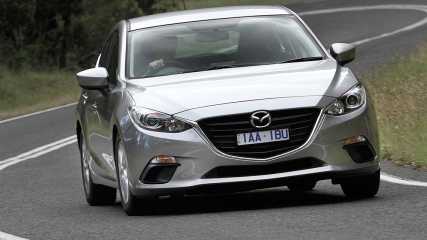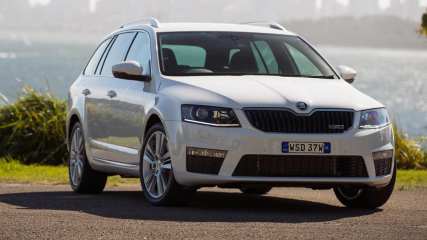Mazda MX-5, Audi A3 Cabriolet and Abarth 595 Convertible 2014 review
By Neil Dowling · 19 Sep 2014
It's the season for convertible cruising and the wind-in-the-hair feeling need not come at great expense.Top-down driving with the wind in your hair isn't solely the province of the rich and famous. For as little as $21,000 drive-away, the sticker price of the little Fiat 500C convertible, you can savour spring motoring.Convertibles don't have to be fast, just cool. And they don't have to be practical because you - and sometimes your partner - are probably the only people enjoying the ride. But they have to be safe.There are about 40 convertible models around. Most exceed $60,000 but prices peak with the $1,075,000 Rolls-Royce Phantom Drophead.Convertibles are counted among sub-$100,000 sports cars, a segment that is powering. Sales are up 24 per cent to the end of August. Expect even stronger spring and summer sales as buyers eye the skies.SPRING SPIDERS This trio will put a smile on your face and won't bite too deep into your wallet. The Abarth 595, Mazda MX-5 and Audi A3 escape machines also suit city and suburban duties.VALUE Compact dimensions, four-cylinder engines and frugal fuel thirst indicate low ownership costs. But they're not in the same budget price band as hatchbacks.Audi's A3 Cabriolet, from $47,300, needs options to cement its prestige aura. Satnav, rear camera etc are packaged for $2000 and you'll have to add $450 for the acoustic roof, which should be standard. That's $49,750 plus on-road costs. There's no capped-price servicing - Audi estimates annual costs of about $500.Abarth's 595 Competizione convertible is the eighth model from the Fiat-owned performance arm. Theoretically, it's not a Fiat so there's are big bragging rights for the car's $39,000 price. Equipment levels are good, from 17-inch spidery alloy wheels to Sabelt race seats, digital instrument panel, full-length electric sunroof and Bluetooth connectivity. Again, no service program though Fiat/Abarth has a service menu. The marque's exclusivity benefits three-year resale, estimated at 61 per cent by Glass's Guide.The Mazda MX-5 is the world's most popular sports car and the only one voted a classic while still in production. There's a new one early next year. Meanwhile the two-seater exemplifies simplicity and a dogged mandate to achieve fine handling using off-the-shelf components.But it's expensive at $47,280 and has been around the block too many times to miss out on features we now expect as standard - park sensors, reverse camera, Bluetooth and so on. Mazda's capped price servicing contains service charges, keeping to as little as $929 for three years. Resale is 53 per cent.DESIGN This is a car segment that is all about "look at me''. Which one will get you the most looks or make you the centre of attention? Here the jury is divided - the Abarth looks as if it's on steroids and on test drew the most attention. The Mazda is clearly a sports car but despite its austere beauty, is too common to turn many heads. The Audi is perfectly proportioned, undeniably elegant and its visual appeal is reinforced by its German badge.The Abarth is all Italian flamboyance with chrome trim, lots of colour and artistic detail. The digital instrument panel is clever and incorporates data including lateral G-forces and the thin, body-hugging seats are trimmed in red cloth. Unnecessarily damaging to image is the Fiat "500C" badge on the passenger-side dash.The electric roof is more an extended fabric sunroof that retreats in stages, culminating in collecting up the rear glass and folding like a bustle above the boot lid masking all rear vision. Luggage space is 182L, expanding to 520L with the rear seats folded.The Mazda has a metal folding roof (also electric and also folding out of sight; there's no longer a cloth-roof model). Cabin detail is sparse but perfectly suited to its sports car theme and all-black materials ensure glare-free driving. Luggage space is only 150L.Inside, the Audi wins. Its cabin is clinical but oozes quality. It can fit four adults, only matched here by the Abarth. The boot is surprisingly spacious at 320L. The cloth roof folds back perfectly in line with the body so it looks classy topless or fully clothed.TECHNOLOGY The Abarth crowds a small but punchy turbo into the tiny nose for frugal use of 91RON petrol. A "sport" mode boosts outputs while race-oriented chassis components include intuitive Koni dampers up front, vented discs all around and dual-weighted steering.The simplest is the Mazda, sharing parts with the family's previous generation passenger cars yet riding on a unique platform. The engine outputs are relatively uninspiring but it's relatively frugal on 95RON fuel. It has perfect weight distribution. Honed suspension components and some aluminium parts (the bonnet, for example) keep weight down to help performance. The six-speed gearbox is shared with the Toyota 86.Riding on VW Group's lauded Golf platform, the Audi has a very taut, composed ride. Its turbo four turns a seven-speed dual-clutch auto for easily the best fuel efficiency, despite being the topweight here.SAFETY The four-star Mazda shows its age while the others, with contemporary safety gear, score five. There is a distinct sense of vulnerability that generally goes with the convertible territory.Audi has seven airbags, front and rear park sensors, active rollover protection and auto wipers and headlights plus optional safety kit. The Abarth has rear park sensors (but desperately needs a camera), tyre pressure alerts, bi-xenon headlights and five airbags. Only the Mazda has no spare; the others have space-savers.DRIVING Noise - and lots of it - is the Abarth's calling card. With engine and exhaust in "sport" mode, it sounds as if it's competing in a World Rally Championship stage.Generally, it's fun to drive, the open-air experience is wonderful. Power pours on, rushing through the beautifully weighted five-speed manual. The steering is pin-sharp and the seats wrap around the body, though the driving position is best for smaller people.When the road gets bumpy, however, the suspension is too hard to be comfortable. The Abarth's ride degenerates into a brutal shake that throws the short-wheelbase car offline through corners and even blurs the driver's vision.Far more domesticated is the venerable Mazda, which is the best at making driver and car fit like hand in glove. You can almost think it through corners, almost move your hips to adjust the rear end and merely apply light steering wheel pressure to arc the tightest corner.Ride comfort and handling are perfectly balanced and even if the engine wants for urge, it's such fun and remarkably competent in the city. Drop the top and you feel as if you're on an oversize skateboard.The Audi, however, takes the honours. The body rigidity and (optional) acoustic cloth roof lining make it feel more like a sedan. The silky smooth engine is incredibly frugal.Top down - it can be dropped at up to 50km/h - the wind buffeting is more than acceptable and the (optional) neck warmers combat crisp morning or evening air. The auto gearbox has a little low-speed lag but, overall, it's a beautifully accomplished car.VERDICT The Abarth is an enraged boiled egg; the Mazda is dictionary definition roadster; the Audi is the recipe for everything topless. Raw-edged owners will pick the Italian, singles will buy the MX-5 and more mature drivers will go for the Audi.WHAT'S A SPIDER?The term "spider" (or marketing variations such as spyder) is apparently drawn from a horse-drawn, light and open two-seater carriage popular in Britain in the era before motor vehicles. The carriage was known as a "speeder" but as the carriage became popular in Italy the phonetic spelling - "spider" - was adopted. As horses made way for internal combustion, small two-seat convertible sportsters became known as "spiders". There is also ostensibly a reference to the original folding-roof frames resembling spindly spider's legs.AT A GLANCE Mazda MX-5: 4/5Price: From $47,280 Warranty: 3 years/unlimited km Capped servicing: From $929 for 3 years Service interval: 6 months/10,000km Resale: 53 per cent Safety: 4 stars ANCAP Engine: 2.0-litre 4-cyl, 118kW/188Nm Transmission: 6-speed man; RWD Thirst: 8.1L/100km, 95RON, 192g/km CO2 Dimensions: 4.0m (L), 1.7m (W), 1.3m (H) Weight: 1167kg Spare: None Audi A3 Cabriolet Attraction: 4.5/5Price: From $47,300 Warranty: 3 years/unlimited km Capped servicing: No Service interval: 12 months/15,000km Resale: 50 per cent Safety: 5 stars ANCAP Engine: 1.4-litre 4-cyl turbo, 103kW/250Nm Transmission: 7-speed dual-clutch auto; FWD Thirst: 4.9L/100km, 95RON, 114g/km CO2 Dimensions: 4.4m (L), 1.8m (W), 1.4m (H) Weight: 1380kg Spare: Space-saver Abarth 595 Competizione: 3.5/5 Price: From $39,000 Warranty: 3 years/150,000km Capped servicing: No Resale: 61 per cent Service interval: 12 months/15,000km Safety: 5 stars ANCAP Engine: 1.4-litre 4-cyl turbo, 118kW/230Nm Transmission: 5-speed man; FWD Thirst: 6.5L/100km, 155g/km CO2 Dimensions: 3.7m (L), 1.6m (W), 1.5m (H) Weight: 1035kgSpare: Space-saver






.jpg)
.jpg)

.jpg)


.jpg)

.jpg)
